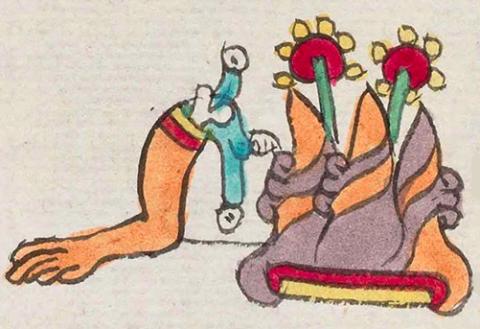Tetzcoco (Mdz3v)
This pair of compound glyphs represents the place name, Tetzcoco. Each of these compound glyphs has elements that can be described separately, but there is a visual ligature (a black line) connecting them. One, on the left, consists of a bent arm with a protruding bone and water (atl) coming out of the top. A red and a yellow band at the top of the arm seems to point to the bone as protruding from the interior of the arm, where the shoulder would be. The details at the top of the arm thus draw attention to the shoulder (acolli). The compound glyph on the right combines three stone (tetl) peaks in the shape of a mountain (tepetl}). The stone of the peaks has the usual wavy, alternating terracotta-colored and purple lines, along with curling, rocky outcroppings on the slopes. At the bottom of these combined peaks are the red and yellow horizontal lines at the base of the mountain that are typical of the tepetl. Two flowers [presumably, xochitl) emerge between the peaks. These have green stems, a large red center, and small yellow circles around that red center. The locative suffix (-co) is not shown visually unless the landscape provides a semantic locative.
Stephanie Wood
The glyph on the left stands for the Acolhuacan region, as can be seen by comparing it with the glyph for Acolhuacan on folio 21 verso. The other glyph, in the right, stands for the city of Tetzcoco. The the start of the place name comes from tetzcotl), a term for small mountain according to the Gran Diccionario del Nahuatl. The te- from tetl, stone, is an added phonetic indicator. The -co locative suffix is sometimes indicated by the presence in some glyphic renditions of Tetzcoco (in other manuscripts) with a ceramic pot (comitl), which is a phonetic indicator, and adds nothing to the meaning. See: Bradley Benton, The Lords of Tetzcoco (2017), 5–6. The flowers in the glyph here have yet to be analyzed.
Stephanie Wood
tetzcuco /. cibdad
[Acolhuacan] Tetzcoco, ciudad
Stephanie Wood
c. 1541, or by 1553 at the latest
Stephanie Wood
hands, arms, mountains, water, bones, huesos, agua, manos, brazos, flores, picos, nombres de lugares, hueso

acol(li), shoulder, https://nahuatl.wired-humanities.org/content/acolli
coltic, curved, bent, https://nahuatl.wired-humanities.org/content/coltic
-hua-, possession, containment, https://nahuatl.wired-humanities.org/content/hua
-can (locative suffix), https://nahuatl.wired-humanities.org/content/can
te(tl), stone or rock, https://nahuatl.wired-humanities.org/content/tetl
Codex Mendoza, folio 3 verso, https://digital.bodleian.ox.ac.uk/objects/2fea788e-2aa2-4f08-b6d9-648c00..., image 17 of 188.
The Bodleian Libraries, University of Oxford, hold the original manuscript, the MS. Arch. Selden. A. 1. This image is published here under the UK Creative Commons, “Attribution-NonCommercial-ShareAlike 3.0 License” (CC-BY-NC-SA 3.0).


